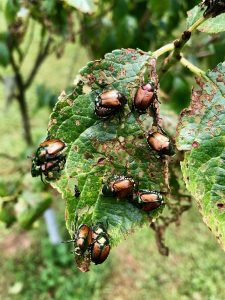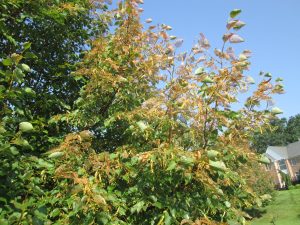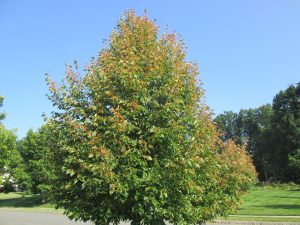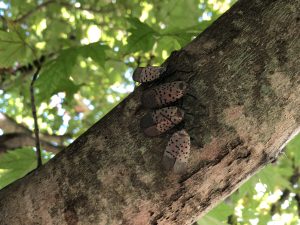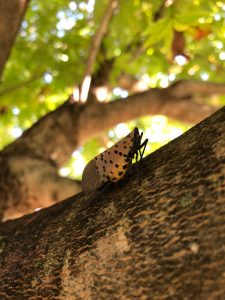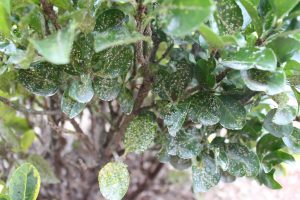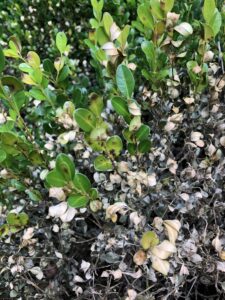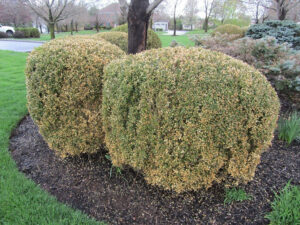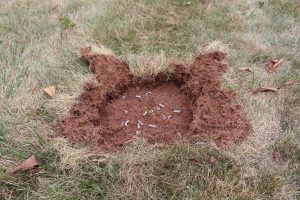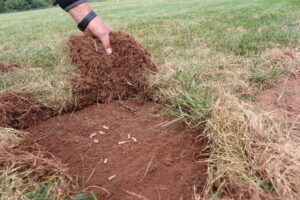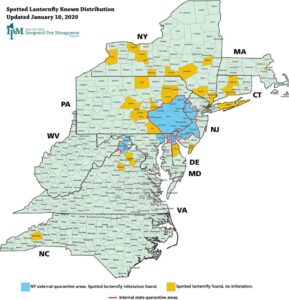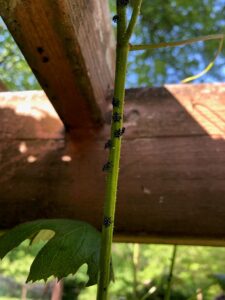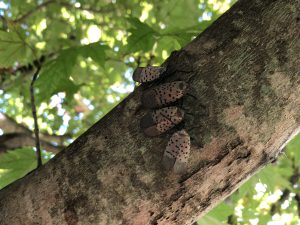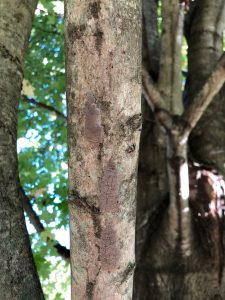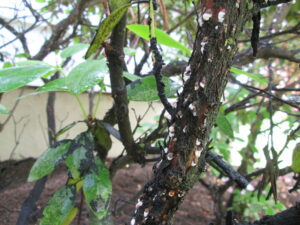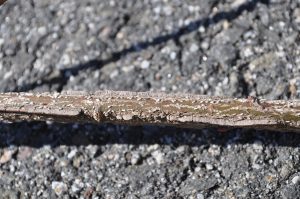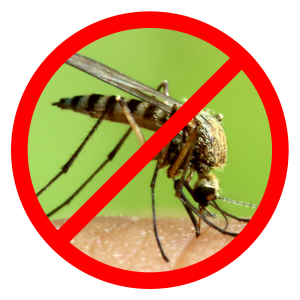Category Archives: Outdoor Pest Control
New Jersey Neonicotinoid Pesticide Ban
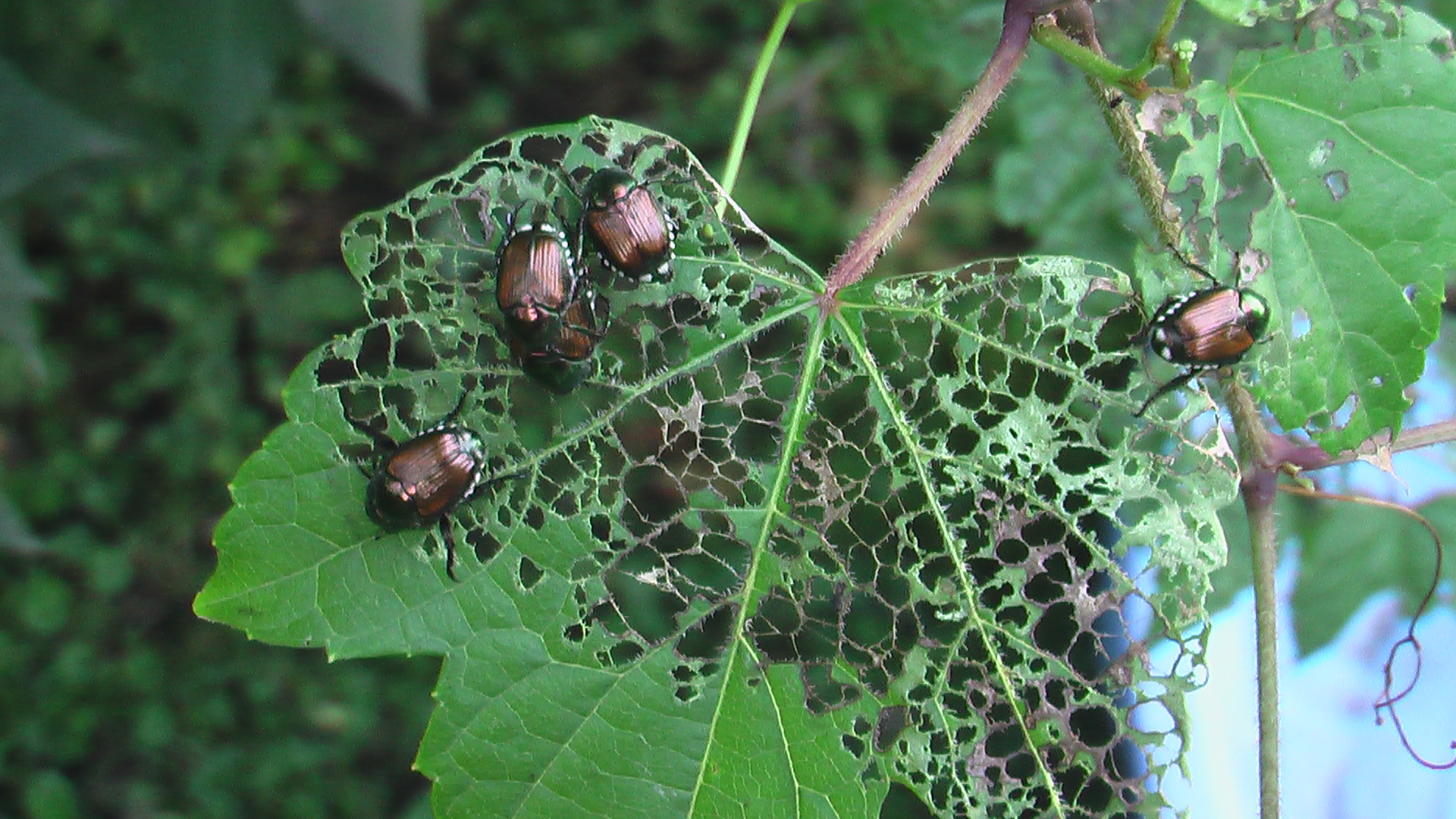
On January 18th 2022, Governor Phil Murphy signed new legislation that affects the use of neonicotinoid pesticides. In summary, the new legislation prohibits any use of neonicotinoid pesticides that is not for agricultural purposes after October 31st, 2023. The intent of this law is to reduce exposure to pollinator insects. In this blog, we will discuss how the new law is going to impact treatments done to your lawn and landscape plants.
What is a neonicotinoid?
Neonicotinoids (Neonics) have been used in agriculture since the 1990s and are one of the most widely used pesticides in the world. They are insecticides that are used to control many common pests found in lawns and landscapes in New Jersey. In addition, they are also in many of the popular flea and tick medications used on pets (neonics are not banned in New Jersey if used on domestic pets). Because neonics are no longer under patent, there are many generics making them an extremely cost-effective option to control insects.
How are they used?
Neonics are commonly used as systemic insecticides used to protect plants from insects that feed on them. A systemic insecticide is one that moves through the plant and provides protection. As an example, Japanese beetles are often found feeding on plants such as roses, cherry trees, plum trees, and even Japanese maples. Neonics can be injected into the soil around the root zone of those plants very early in the spring. The plants will absorb and translocate the product. By the time Japanese beetles come around to feed on the plants in the summer, the plants will be protected and the insects will be controlled once they begin to feed.
Japanese beetles are just one example, there are many other insects that are controlled by neonicotinoids. In the past few years, many of us in New Jersey have noticed invasive spotted lanternflies around our homes and landscapes. Neonics were a great way to control these insects. Lanternflies have a few favorite trees they like to feed on, tree of heaven and a few maple varieties were the primary targets in our service area. We were able to protect those plants with a single systemic treatment that provided control during the entire adult life cycle of the lanternflies. In addition to protecting the plant, it also provided a great way of reducing the population of an invasive species that caused millions of dollars of damage to local crops.
It’s easier to talk about the insects controlled with neonics because if we look at plants treated with neonicotinoids, the list will likely include all ornamental plants in our area. We’ve already mentioned some of the plants, but other plants treated with neonicotinoids include Magnolias, Azaleas, Boxwoods, Ash Trees, Maple Trees, Hemlocks, Birch Trees, and these are just a few.
Trees and shrubs are not the only plants that benefitted from treatments, your lawn was also protected by neonics. We already discussed the harm Japanese Beetle adults do by feeding on your plants, but they can also cause a lot of harm to your lawn. Beetle adults will lay their eggs in turf, the eggs will hatch into larvae that feed on the roots of grass plants. These larvae are commonly referred to as grubs. If you’ve ever had grubs in your lawn then you are familiar with the amount of damage they can do to turf. Large sections of dead grass can be rolled up like a carpet after grubs feed through an area. Neonics applied to the turf were a great way to preventatively treat for grubs and protect your grass.
We can go on and on with examples of insects controlled by neonics. Rather than go into detail on each one, a few more that you are probably familiar with are boxwood leafminers, scale, adelgids, and even invasive emerald ash borers. In fact, a lot of piercing and sucking insects can be controlled with neonics.
What does this mean for homeowners in New Jersey?
With the current products available for use in New Jersey, the days of a single systemic treatment to protect a plant for the year are behind us. There are a few systemic insecticides available that are not neonics, however, they do not cover a broad spectrum of pests and can’t be used to control many common insects in our area. In addition, the cost of those systemic insecticides will likely exceed the value of the plant in many instances.
With that being said, we still have options to control insects on our landscape plants and turf. Since we can no longer treat plants systemically, we have to treat them when the insects are active. Leafminers are insects that cause a lot of damage to boxwoods each year. The adults are active between April and July and can be targeted during that time frame with monthly contact sprays. The obvious downside to this is going from a single annual treatment to monthly treatments that will need to be applied 3 or 4 times a year to protect the plant. The same is true for many other insect pests in our area, a single treatment will be replaced with much more specialized treatments targeted during the timeframe when those insects are most vulnerable.
What should we do to protect our landscape plants?
As mentioned above, there are some systemic options still available for certain plants, however, the products are much more expensive at this point in time. We do expect costs to come down in the near future as some products come off patent and other new products are developed.
The most common form of treatment now will be specialized contact sprays designed to target specific insects at the most opportune time to treat them. The timing of applications, as well as the specific products used to treat the insects, will vary greatly depending on the plant and insect. If you are in our service area and scheduled for a systemic treatment, then we’ve likely already contacted you to discuss treatment options for your property. If you’re not in our service area, we recommend contacting your local tree company to see what treatment options are available and recommended for your plants.
Spotted Lanternfly
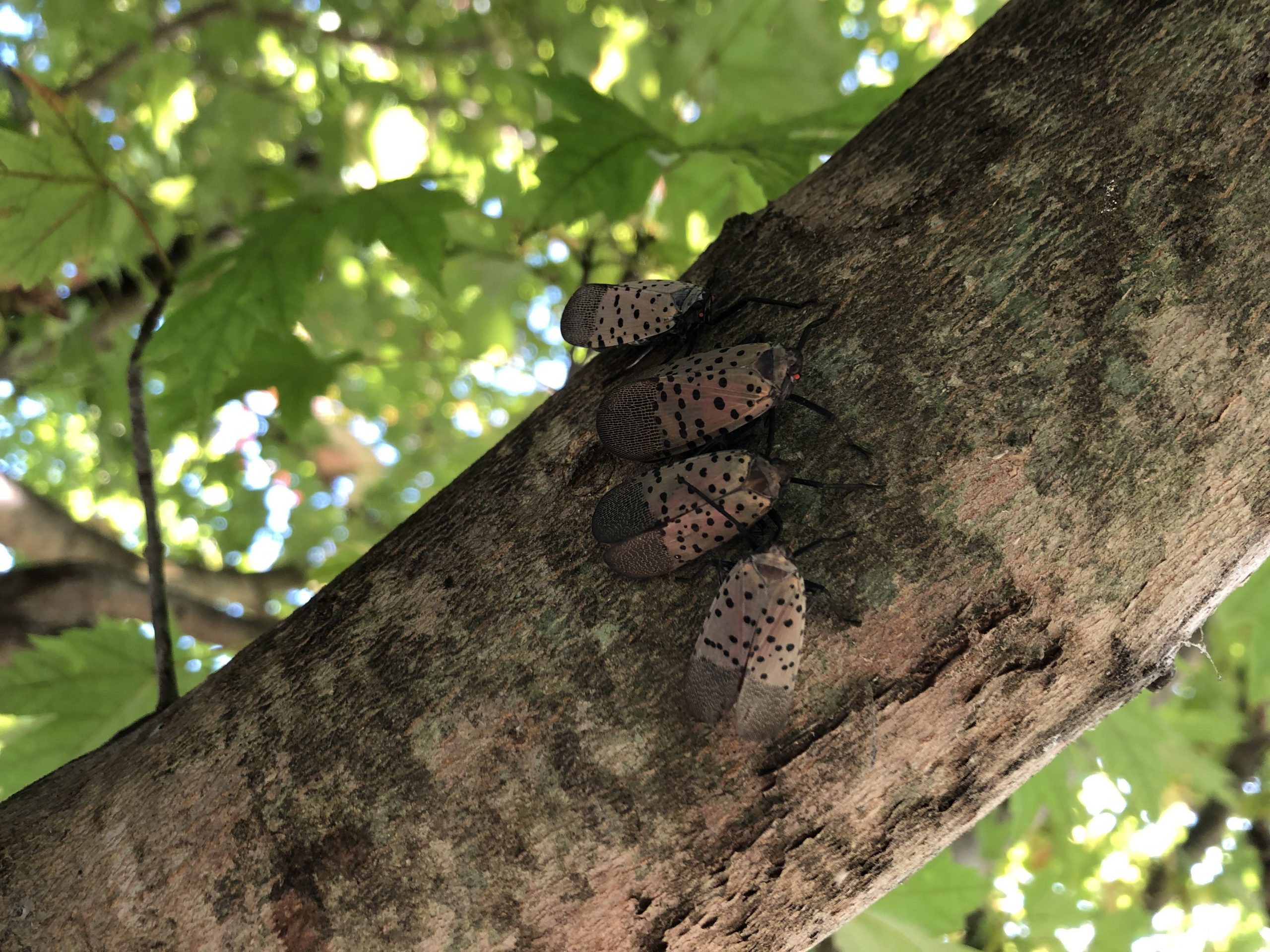
You may have heard about a new pest that has invaded landscapes in New Jersey and other surrounding states: The spotted lanternfly. This insect is an invasive plant hopper, which means that it can be found on multiple species of plants. Since the spotted lanternfly is not limited to a specific plant, it can be, and likely will be, a formidable pest in our landscape.
The spotted lanternfly originated in China, Vietnam, and India. It was first confirmed in the United States in 2014, when it was found in Pennsylvania. It is believed they hitchhiked here on landscape rocks. Since then, the spotted lanternfly has spread to New Jersey and several other surrounding states. Below is the spotted lanternfly distribution map from the New York State Integrated Pest Management website.
Spotted Lanternfly distribution map
Stages of the Spotted Lanternfly
The spotted lanternfly has one generation per year, with four nymph stages, an adult stage, and then overwinter in egg masses. The early nymph stages of the spotted lanternfly are usually found in the May-June timeframe, they are approximately ¼ of an inch long, black in color with white spots.
As they progress, the nymphs grow to about ¾ of an inch long and turn red in color, with black and white spots. Adult spotted lanternflies will reach 1 inch in length.
The adult spotted lanternfly has pinkish-tan, black-spotted folded wings. Both the male and female spotted lanternfly have a yellow abdomen with black bands. When the spotted lanternfly takes flight, the wings are moth-like and spread to about two inches.
Egg masses are found from October through the following spring. Spotted lanternfly egg masses have been found on trees, rocks, playsets, cars, etc. They look like a blotch of mud sticking to a hard surface and have a waxy covering. Additionally, each female potted lanternfly can lay one or two egg masses containing 30-60 eggs.
Spotted lanternfly Damage
The spotted lanternfly’s preferred host is the Tree of Heaven, Ailanthus altissima; however, they have been found on over 70 different plant species, including fruit trees, maples, and grapevines. In fact, there are several wineries in Pennsylvania that have lost significant portions of their crop in 2019 due to damage caused by the spotted lanternfly.
The spotted lanternfly damages plants by feeding on the sap. When the spotted lanternfly feeds on trees, they excrete a sugary substance called ‘Honeydew’. Sooty mold fungus is a dark colored fungus that grows on the honeydew and is a clear identifier of an insect issue on trees and shrubs. Since this pest can gather by the hundreds on trees, there is potential for significant damage. In large infestations, standing under a tree without an umbrella will not be a pleasant experience as you may feel the honeydew dripping on you like rain!
How to get rid of Spotted Lanternfly
So, what can you do about this pest? Since it is a relatively new pest to our area, Universities are still doing research on them. However, there are some things that can be done to minimize the spread and damage caused by spotted lanternflies.
- Removal of ‘Tree of Heaven’ on the property. Since this tree is the preferred host, many wineries and fruit farms have removed these trees surrounding their properties.
- Scout your property from June-October for spotted lanternfly activity.
- Inspect smooth surfaces from late fall to early spring for egg masses. This pretty much means everything outside that has a smooth surface. If you do see egg masses, scrape them off with a rigid plastic card into a bag. Once that is done, pour rubbing alcohol into the bag to kill the eggs.
- There are insecticides labeled to treat this pest, both curative and preventative. ‘Curative’ means treating them while they are actively feeding. ‘Preventative’ means treating the plant well before an expected infestation. Generally speaking, it is best to have a professional service apply insecticides.
- See it, squash it, smash it, kill it. Pretty self-explanatory.
In Conclusion
The spotted lanternfly has spread rapidly from a small area in Pennsylvania since 2014. They are now in New Jersey and at this point, you may have already noticed the adults on your property. They can be both a major nuisance to people and a pest to plants. If you have any questions about the spotted lanternfly, please give us a call.
For more information on Spotted lanternfly visit:
https://extension.psu.edu/spotted-lanternfly
https://www.nj.gov/agriculture/divisions/pi/prog/spottedlanternfly.html
Bagworms and Treatment Methods
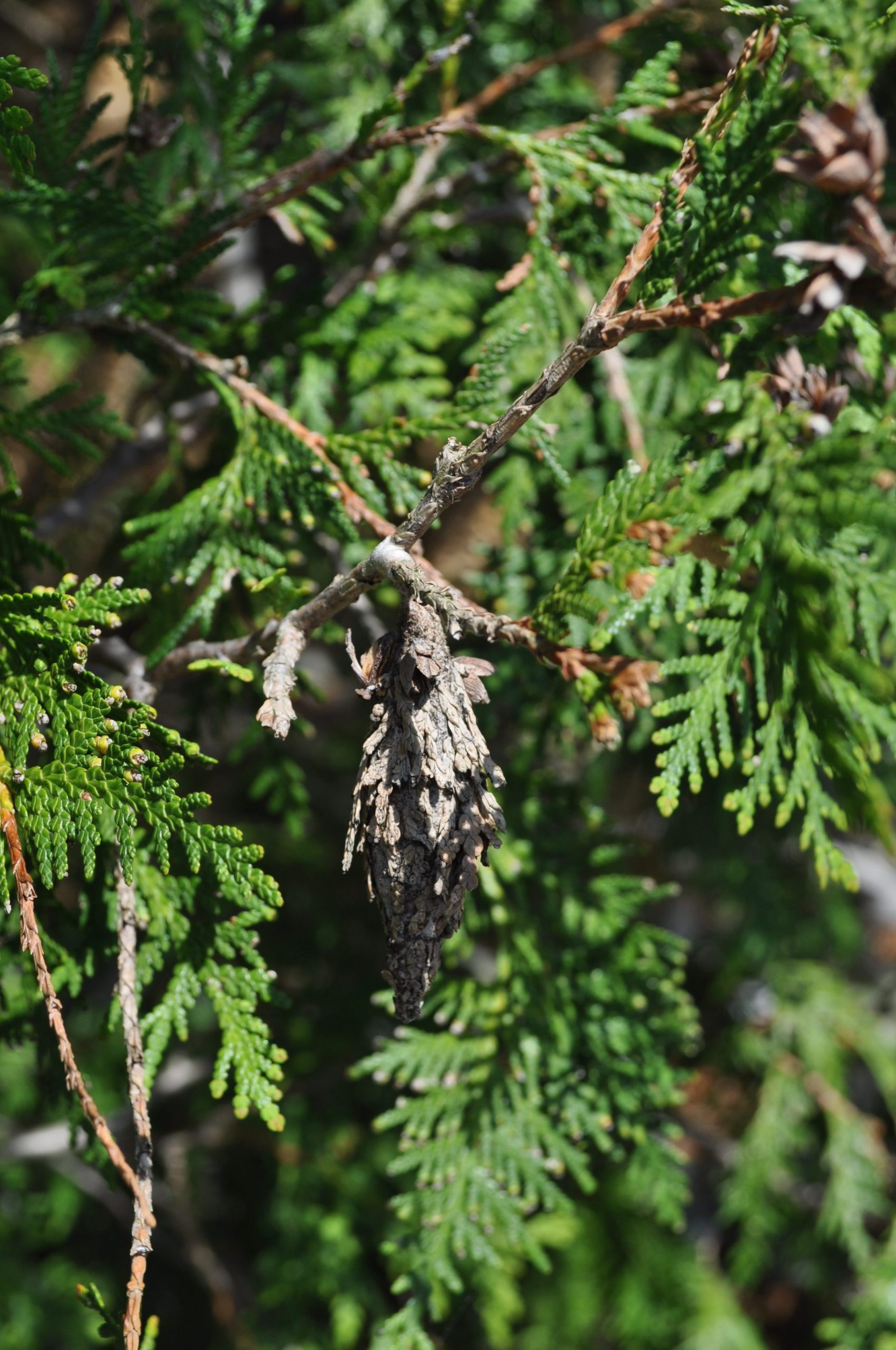
Have you ever noticed pine cone shaped or cocoon-like sacs on ornamental trees and shrubs in the spring and summer time? These are not normal pine cones that we see on evergreen plants in the winter time, instead they are a type of caterpillar that creates this ‘bag’ around it as it feeds on the host plants. Bagworms can cause substantial damage to ornamental trees and shrubs, which makes various treatment options important for homeowners with effected plants.
What do Bagworms look like?
Most notably known for the ‘bag’ the larvae make out of silk has an exterior of leaves or pieces of twigs from the host plant it is currently inhabits.
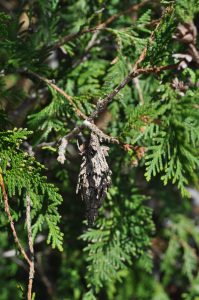
A close-up look at a bagworm sac.
The larvae are dark brown with a yellow head and yellow and black spots on their bodies. While. the adult males look like moths that are a sooty black color, hairy and have almost clear wings that can span to one inch in diameter. The adult females, seldom seen, and are wingless, lack any functioning eyes, antennae, or legs. The adult females remain in the bag as they are not able to fly or move easily like the males.
Host Plants
Common to the New Jersey and East Coast, the bagworm can affect a large variety of trees and shrubs that are popular to this area. For example, some evergreen varieties of plants commonly affected by Bagworms include; arborvitae, juniper, cedar, fir, pine and spruce. These plants are largely popular among residential landscapes, making heavy infestation of Bagworms detrimental to landscapes in our area. Bagworms are found on other trees an shrubs such as rose bushes, maple, elm, black locust and sycamore.
Bagworm Damage
The primary damage caused by Bagworms is tree defoliation and brown spots. The bagworm larvae feed on the upper layer of leaves or needles on the ornamental trees and shrubs it is attached to. Heavy infestation of bag worms can leave plants looking completely defoliated and can eventually lead to severely damaged trees and even the death of the plant.
Bagworm Life Cycle
The spring time is when we first start to see bagworms hatch and immediately start to feed on the foliage of the host plant. In our area, bagworms really begin feeding on plants between May to early June. During this time, they also construct the bag like outer shell, and continues to feed on the plant only emerging from the bag a small amount when feeding.
In the summer time, the larvae stops feeding on the plant, and this occurs between late July to mid-August. This is when the larvae goes completely inside the bag, closing it up with a band of silk to enter the next stage of its life. This pupal state lasts around four weeks long, bringing the insect to the next season.
Starting in the fall, the bagworm males emerge from their bags as moth like insects. The male insect then flies around to find a female mate. The adult females remain in their bag and produce a pheromone to attack males. Once the insects mate, the female deposits between 500-1000 eggs in the bag and then both adult insects die after reproduction.
Through the winter, the eggs in the abandoned bag remain protected through the harsh weather months. In the spring, the eggs hatch and start the next generation of bagworms.
Bagworm Control and Treatment
There are a couple methods of control when dealing with bagworms; there is manual removal, natural predators, and chemical control. First, we can talk about manual removal. This method is only effective when you have detected the bagworms early; meaning late fall, through the winter, or before the larvae hatch in the spring. You can manually cut the bag from the ornamental tree with pruning shears. We recommend disposing of the bags in a separate bag and removing them off your property Manual removal is also only reasonable when a bagworm population is low.
Natural predators for bagworm control include certain bird species, insects and fungi. We do not recommend relying on natural controls when dealing with bagworm infestation on your ornamental trees and shrubs as damage is still likely to occur.
Finally, there is chemical control. For the treatment of bagworms, we recommend contacting your local ornamental tree service who can safely apply an insecticide in the spring once the larvae have emerged from their bag.
Conclusion
Bagworms can cause substantial damage to ornamental trees and shrubs on a property and we do not recommend ignoring their presence as they can lead to tree death. If you are in our service area and would like to receive an estimate for bagworm treatment, request an estimate today. Our licensed technicians have the knowledge to work with customers on creating a plan to treat the insect.
The Benefits of Preventative Grub Control
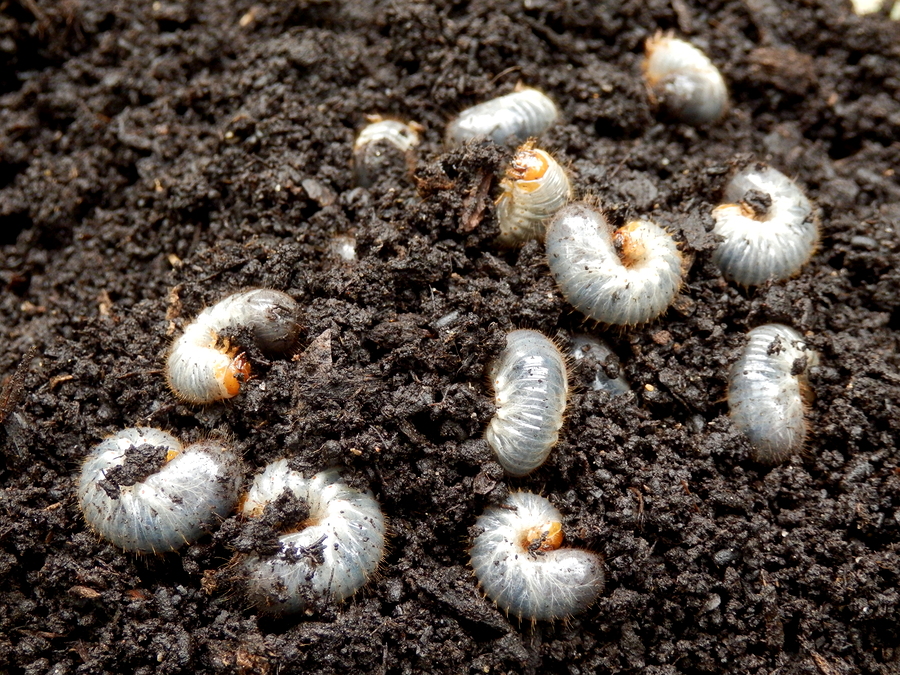
As the old saying goes “an ounce of prevention is worth a pound of cure.” This statement is spot on when it comes to preventing grubs and the damage associated with them.
Beetle Life Cycle
Before we get into the benefits of preventative grub control, we need to understand grubs and how they can impact your lawn. Grubs are the sub-surface larval stage of beetles. Although there are several types of beetles, most people are familiar with Japanese Beetles because they like to dine on our favorite trees and shrubs. Beetle species in our area typically lay eggs in the summer, sometime between June and early August depending on the species and environmental conditions.
The eggs hatch into grubs, which survive by eating plant roots, especially grass plants. Over time, as the larvae continue to feed, areas of the lawn turn brown and feel sponge like as you walk over it. An easy way to determine if grubs are the culprit is to pull on the actual grass plants. The grass pulls right up like a carpet and expose the feeding grubs underneath. The grubs are typically white and shaped like the letter C.
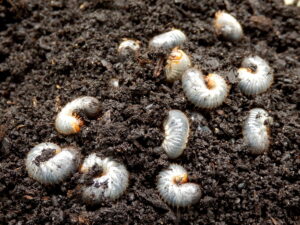
White grubs burrowing into the soil. The larva of a chafer beetle, sometimes known as the May beetle, June bug or June Beetle.
Grub Prevention
To avoid having this happen to your lawn, apply a preventative grub control to the lawn in the summer. The product moves into the soil prior to the eggs hatching, providing protection to your plants from feeding larvae. The application is very effective at controlling grubs and saves you lots of time and money compared to dealing with the issue after the fact.
Post-Emergent Grub Control
If you did apply a preventative grub control, and you find grubs damaging your lawn, there are still things you can do to help. You should treat the grubs, but keep in mind the treatment is less effective when compared to preventative treatments because the grubs are larger and more mature. Every person on the planet is not born on the same day, we all have different birthdays. The same can be said for grubs. They don’t all hatch from their eggs in the soil on the same day. The younger the grub the more effective the material is on it, the older (more mature) the grub, the less effective the material is on it. At this point it is safe to say that this material applied at this stage will produce about 60-70 percent control results on the actively feeding grubs. Typically, the treatments to control the grubs at this stage of their life cycle requires heavy watering after the application as well. This helps move the product to the root zone, where the grubs are feeding.
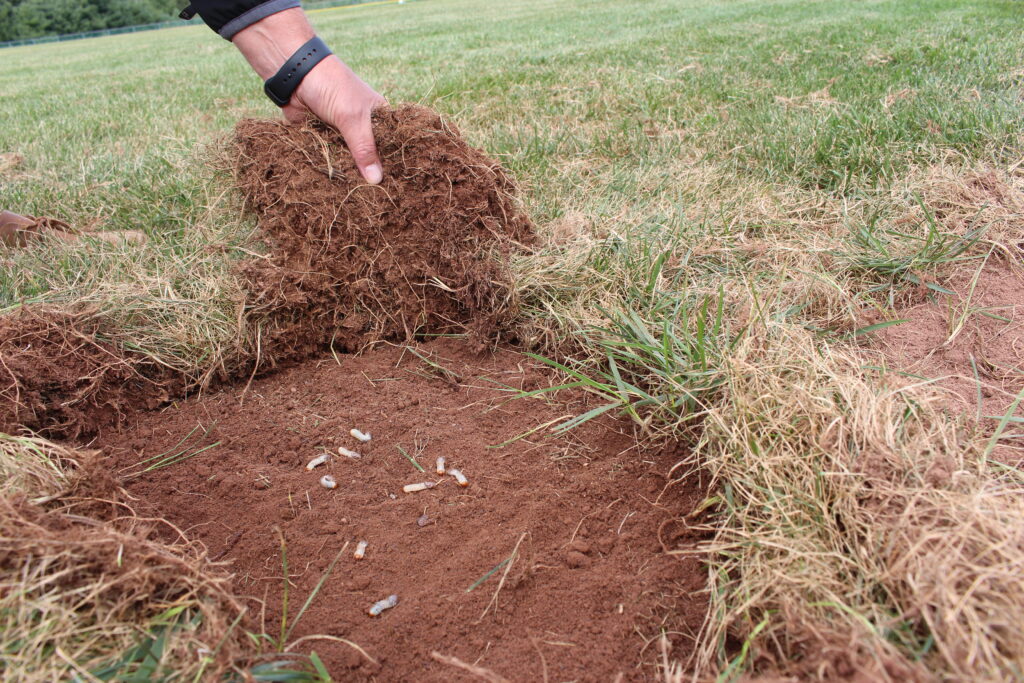
When grubs have caused damage to turf, the grass can be easily separated from the soil exposing the grubs underneath.
What is more cost effective?
One benefit to preventative grub control is saving money. Products used to preventatively treat grubs are typically much cheaper than the ones used to control them after they have matured. The results are also more effective when treating them preventatively, so you’re getting better control at a lower cost.
Because grubs feed on the root system, the damage they cause kills the plant and reseeding will be necessary to help those areas recover. Another benefit to preventatively controlling grubs is you won’t have to spend your time and money reseeding grub damaged areas of your turf, that is often very costly.
Conclusion
A little bit of prevention goes a long way when it comes to grub control. Save yourself the time and hassle associated with controlling mature grubs and reseeding damaged areas by getting a preventative grub control application this summer. Whether you do it yourself or have a lawn care professional apply the treatment, we highly recommend it. If you are in our service area and have any questions about grub control, feel free to contact us at 908-281-7888.
Japanese Beetles

Unfortunately for New Jersey residents, the Japanese beetle causes damage on lawns and plants everywhere. Japanese beetles have been found to feed on over 275 species of plants. This little beetle feeds on the leaves, fruits, and flowers of many plants, including the lindon, Japanese maple, cherry, plum and crabapple trees. Additionally, rose plants are some of their favorite plants to feed on in many landscapes. Luckily, there are plants they do not like to feed on as well; this includes arborvitae, lilac, euonymus, holly and rhododendron. Serious defoliation may occur in heavily infested areas. Not only can beetles defoliate many plants in a short amount of time but their young (grubs) can destroy turf grass as well.
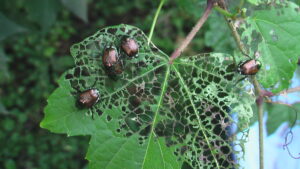
Where did it come from?
The Japanese beetle was found in New Jersey in a nursery in 1916, and prior to this time the pest was only found in Japan where it did not cause substantial damage to plants and turf. New Jersey proved to provide favorable climate with vast amounts of open land and hundreds of plant varieties, making for the perfect location to survive and flourish. Unfortunately for New Jersey, there are no natural predators that would help control the Japanese beetle population here in the United States, explaining the devastating effects the insect has on our turf and plants.
Japanese Beetle Life Cycle
The identification of Japanese beetles is simple. They are ½ inch long, with a metallic green body and brown wing covers with white tufts of hairs on the edges of the wings. Japanese beetles overwinter as a grub in the soil and in the spring, the grubs move up towards the soil surface and feed on grass roots. At this time, the grubs go through their metamorphosis and change into adult beetles. The adult beetles begin to emerge in late June and are active until late September. Most beetles live between three to four weeks and female Japanese beetles lay 40 to 60 eggs over their lifespan.
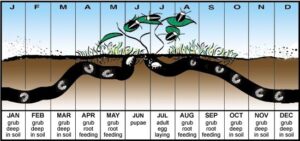
Treatment for Japanese Beetles
One option for treating Japanese beetles is a contact pesticide spray. Pesticide treatments applied while adult beetles are active gives only partial control, even if weekly treatments are applied. These types of treatments are mainly used to stop the vast majority of the beetles present on your plant material from devouring your landscape, but unfortunately provide little residual control when new populations of beetles move in to feed. Foliar spray treatments for Japanese beetles work well for beetles that are actively feeding during the time of treatment, but please be advised that beetles may return and can continue to do further damage to your landscape plants.
The best defense against these pests are preventative treatments for your plants with a systemic soil injection of an insect control product. This application goes into the soil around the root system of the particular plants that beetles like to feed on. The material is then taken up by the plant through its vascular system and then dispersed into the leaves. Beetles must feed on the foliage of the plant to ingest the product before being affected. Therefore, some feeding damage may be present on the plant, but very minimal compared to no control. Treating the beetles during their grub stage is also a good idea for control. Applying a grub preventative to your lawn between June and the end of July helps suppress the grubs and reduce damage to the lawn. If high levels of grubs are present in a small area of lawn, the turf turns brown and peels back like a carpet, exposing the grubs underneath, causing permanent damage to the lawn. You may also find damage to the lawn done by birds, skunks and other vertebrate mammals digging up the ground to find and eat the grubs.
We also recommend that you DO NOT put Japanese beetle traps in the lawn or landscaped areas. Beetle traps often prove to be counterproductive because they attract beetles to your property which increases the amount of feeding damage that can occur. If you have already purchased these bags, we recommend returning them if you can. The damage to your plants could be worse with these traps present than if you had done nothing at all. The less beetles coming onto your property the better off you and your landscape will be.
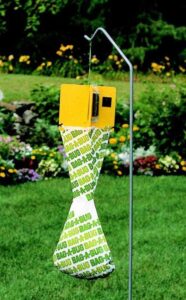
Conclusion
Japanese beetles can become a major problem if left untreated. If you suspect that you may have a Japanese beetle problem in your landscape and are located within our service area, please feel free to contact Fairway Green Inc. with any questions or for a free evaluation and estimate.
Scale Insects on Landscape Plants
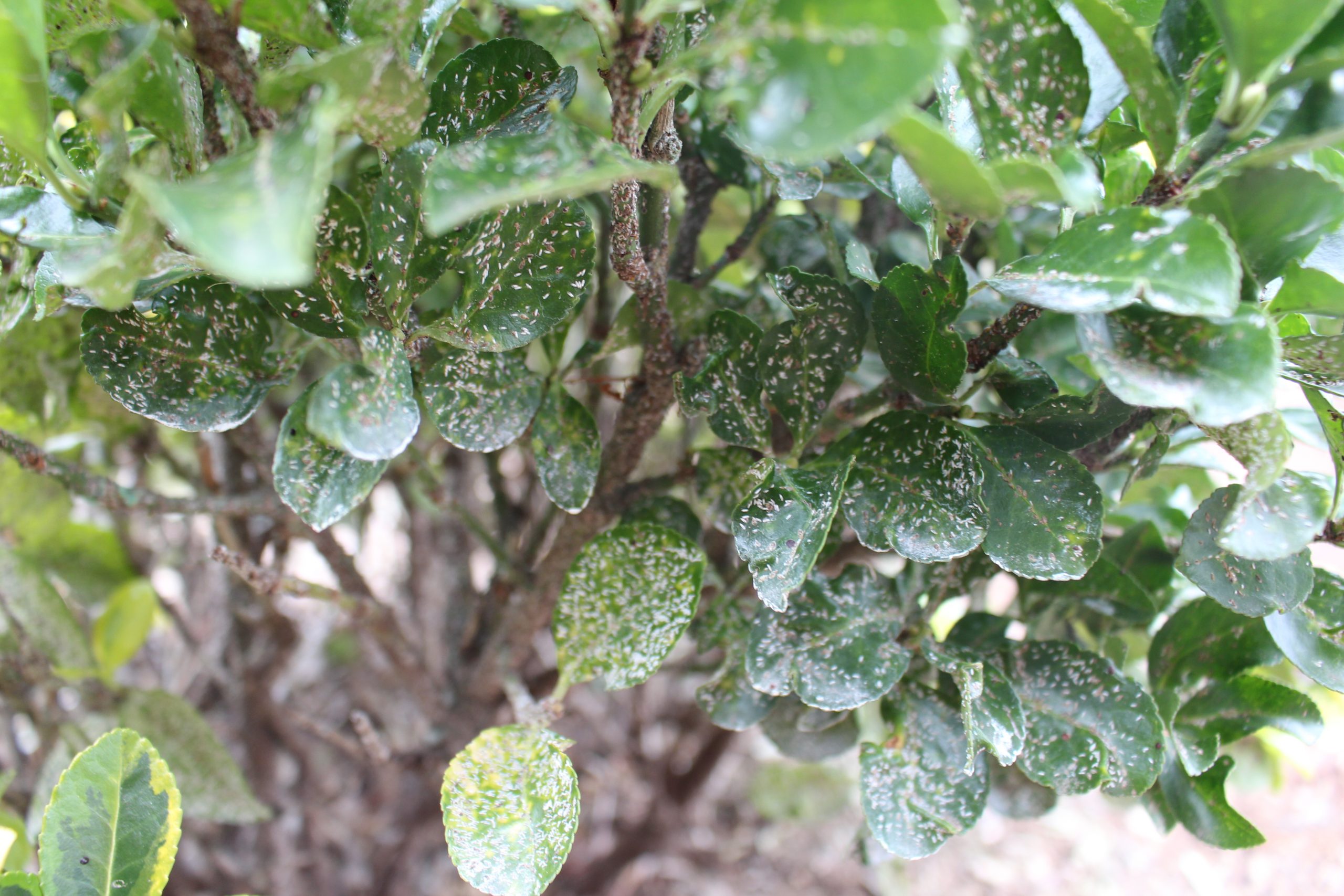
Scale insects hiding on plants in New Jersey can cause substantial damage to a homeowner’s landscape. Of the most common insects, scale is a small insect that feeds on sap from many plants. Below we discuss the two main categories of scale insects, the damage they cause, their life cycle and the ways to control the insect.
There are many varieties of scale insects, however all are sap feeding insects and feed on most types of shade trees, fruit trees, and ornamental shrubs. Scale differs from other insects because they feed on trees and shrubs through a mouth piece that pierces the tissue of the plant, similar to a straw. Most notability, these insects get their name from the scale-like covering that conceals their body.
The two types of Scale
The scale species can largely be broken up into two categories: soft scales and armored scales. Soft scales produce a smooth, cotton-like or waxy surface over themselves and is inseparable from the insect’s body. A distinguishing trait for the soft scale insects is that it produces honeydew from excess sap. This honeydew makes leaves and stems appear shiny or wet and attracts ants, flies, bees, wasps, and other similar insects. Armored scales, based on their name, have a hard-flattened shield-like covering that is not actually attached to the body of the insects.
Damage to plants
A large scale infestation on a plant can cause and lead to several problems for the plant. The leaves of the plant can start to wilt and turn yellow in color, the plants could appear weak, unhealthy, and in some plants, it may also cause death of the plant. Scale damage can also lead to overall weakening of the plant. A weakened plant becomes more susceptible to injury from drought, severe winters we often experience in New Jersey, attacks from other insects and disease. Unfortunately, many types of scale insects are hard to see due to their small size and populations of scale build up over years until plant damage is noticeable. This makes noticing scale insects before it is a larger problem very difficult for the average person.
Scale Life Cycle
The scale life cycle is rather simple, the adult females remain in a fixed location and lay eggs under their shield-like scale. As the eggs hatch, the tiny nymphs equipped with legs, eyes and an antenna allows them to walk away from the maternal cover in search for a new feeding site. This life stage of the scale is often referred to as “crawlers” due to their ability to walk or crawl to a new feeding site. From there, when they have found a suitable location to feed, they insert their feeding mouthpart into the plant and begin feeding on the plant’s sap. The shield like covering the scale insect starts to develop after feeding begins. Separately, adult males resemble tiny flying gnats that fly around to find new females for mating. In a given year, scales can go through one or more generations.
Natural Scale Insect Control
Managing the control of these tiny insects can be difficult because their outer covering creates a barrier to traditional insecticides. Although it may sound hard to manage these pets, an integrated approach can provide substantial control to minimize damage to your plants. First there are the biological controls, which includes introducing natural predators and parasitoids to the infested plants that can attack and significantly reduce scale populations. There is also mechanical control, this is only practical on small infestations and on small trees and shrubs. Trying to mechanically remove large infestations on plants may be very difficult.
Chemical Control
Finally, there is chemical control, which is often the most common and effective way to reduce and control scale insects. There are three chemical control strategies that have been effective when used together treating infested plants. First, a dormant oil spray applied to the plant prior to budding in the spring. If you plan on applying your own dormant oil spray, we recommend carefully reading the product’s label because some plants are sensitive to the oil and cannot be sprayed.
Next, is a traditional contact insecticide spray that should be applied when the “crawler” nymph stage of the scale is active. The insecticide is effective for the nymph stage of the insect because they do not yet have an outer protective barrier.
Lastly, a systemic soil injection is an insecticide that circulates through the plant and controls for both crawlers and adult scales. It is important to note that we recommend the use of all three chemical control options when dealing with a scale infestation because they effect the scales at different phases of their life cycle.
Conclusion
Although the scale insect can be difficult to control, a program that address the pest at all aspects of the life-cycle should provide significant results for most scales on the trees and shrubs in landscapes. If you are in our service area and think your landscape is being affected by scale, Fairway Green Inc,’s Tree and Shrub specialists can perform all three applications at the appropriate time of year. If you are interested in receiving a free estimate, please let us know.
Mosquito Control Treatment
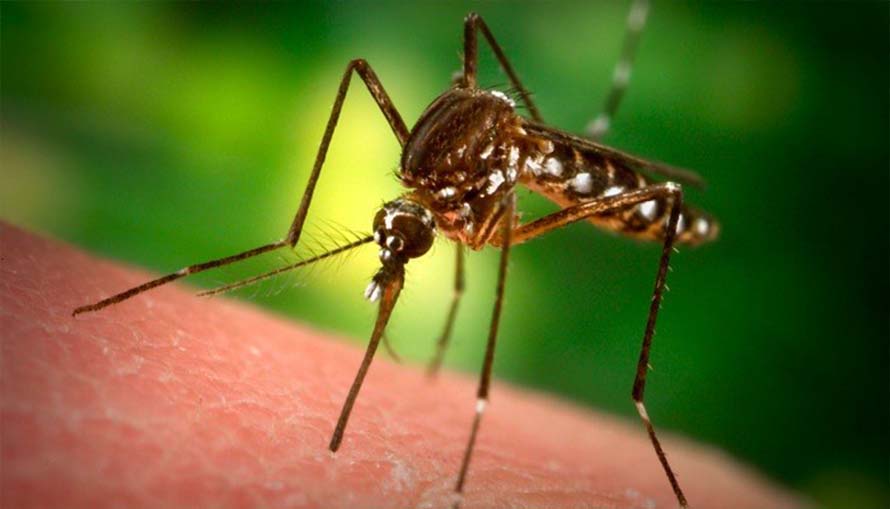
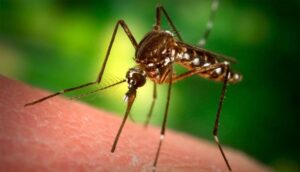 Nothing interrupts a pleasant evening quite like a mosquito buzzing around your ear. Mosquitoes are certainly annoying and their bites can be aggravating. They can also carry mosquito-borne diseases which make them a serious health and safety concern. Millions of people worldwide are impacted by mosquito-borne illnesses every year. Not only can mosquitoes carry diseases that afflict humans, they also transmit several diseases and parasites that affect pets such as heartworm and the West Nile Virus. When it comes to achieving an outdoor space without mosquitoes, we recommend following cultural practices that will reduce the areas that hold water and applying mosquito control treatments.
Nothing interrupts a pleasant evening quite like a mosquito buzzing around your ear. Mosquitoes are certainly annoying and their bites can be aggravating. They can also carry mosquito-borne diseases which make them a serious health and safety concern. Millions of people worldwide are impacted by mosquito-borne illnesses every year. Not only can mosquitoes carry diseases that afflict humans, they also transmit several diseases and parasites that affect pets such as heartworm and the West Nile Virus. When it comes to achieving an outdoor space without mosquitoes, we recommend following cultural practices that will reduce the areas that hold water and applying mosquito control treatments.
Mosquito Life Cycle
Mosquitoes develop through four life stages: egg, larva, pupa and adult. The first life stage is the egg stage. Eggs of mosquitoes are often black in color, cylindrical or spindle-shaped and not visible to the naked eye. Female mosquitoes lay their eggs directly into water or in an area that is moist and will later flood.
The next stage of a mosquito life cycle is the larvae stage. Mosquito eggs often are ready to hatch when and if the conditions are suitable in three to ten days. The larvae emerge the egg and swims directly into the water the egg was laid in. The larvae stage is always aquatic but remains on or close to the water’s service to breath air. During the larval stage, they feed on microorganisms and organic matter.
The third stage is the pupa stage. The pupa are in the shape of a comma and do not feed on the small particles like the larvae. They are quite active and can move throughout the water profile. This short stage can last up to four to five days. This is a metamorphic stage that is similar to a caterpillar and butterfly in that the pupa changes its shape into the adult form. When the pupa emerges as an adult the mosquito, it will rest on the surface of the water until its skin hardens and its wings dry and flies away.
The final stage is the adult stage. The primary function of an adult mosquito is to reproduce. Locating mates takes up a lot of energy, which both male and females will feed on plant juices and nectar to replenish their spent energy flying around. Female mosquitoes also require blood meals to produce eggs.
 A mosquito’s lifecycle spans anywhere from 4 to 14 days depending on temperature, allowing the species to reproduce at a very quick and alarming rate. There are over sixty mosquito species known here in New Jersey. Any type of water that the female mosquito lays her eggs in is called the “larval habitat”. Every type of water source in the environment will accommodate the larvae stage for a mosquito. Some species of mosquitoes will look for freshwater swamps or woodland pools while some will go to salt marshes or standing water lefts anywhere on your property.
A mosquito’s lifecycle spans anywhere from 4 to 14 days depending on temperature, allowing the species to reproduce at a very quick and alarming rate. There are over sixty mosquito species known here in New Jersey. Any type of water that the female mosquito lays her eggs in is called the “larval habitat”. Every type of water source in the environment will accommodate the larvae stage for a mosquito. Some species of mosquitoes will look for freshwater swamps or woodland pools while some will go to salt marshes or standing water lefts anywhere on your property.
What can you do to help reduce mosquito populations at your home?
Homeowners can contribute to reducing mosquito populations by eliminating standing water or areas that have the potential to hold water around your home. Some of these areas include the following:
- Outdoor pots and decorative containers – drain standing water from pots and containers
- Old tires – move tires indoors or reposition to minimize exposure to rain water
- Bird baths – consider changing the water in a bird bath every three or four days
- Clogged gutters – keep gutters clean and clear of debris to ensure proper draining
- Swimming pools or hot tubs – unopened water sources that are stagnant are great breeding locations for mosquitoes
- Overgrown plant material¬ – remove or cut overgrown plant material to reduce mosquito resting sites
What else can you do?
In addition to following the cultural practices, we believe applying mosquito control treatments that can aid in reducing the population of mosquitoes in your outdoor living space.
We recommend applying five monthly applications from May to September to ensure continual control of the mosquito populations in your outdoor space from the spring to summer. Our full Mosquito Control Program consists of five monthly applications with either Conventional or All-Natural products. The mosquito control treatments are applied monthly targeting mosquito habitat on your property. You can choose a conventional control product or an all-natural product.
We also offer single mosquito control treatments for your special outdoor events. Are you planning an outdoor event or having friends over for a barbecue? Keep your guests outside and the uninvited mosquitoes away by scheduling a one-time application. For one-time mosquito control treatments, please provide a minimum notice of one week prior to your event for scheduling this application.
In Conclusion
Achieving a reprieve from mosquitoes this summer is possible for your outdoor space between monthly mosquito control treatments and cultural practices. To learn more about our mosquito control treatments and our five-application program, request an estimate or give our office a call at 908-281-7888.
Eastern Tent Caterpillar Moths
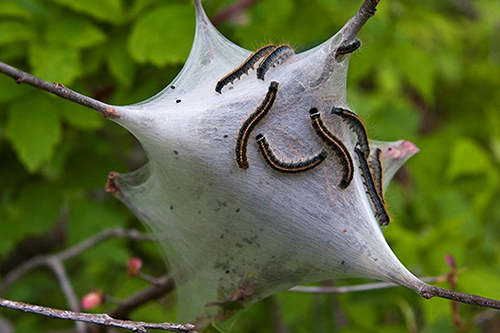
About Tent Caterpillars
The eastern tent caterpillar moth is a native North American pest, that can regularly be found throughout New Jersey. Tent caterpillar nests are a common sight on cherry, apple and crabapple trees in the late spring and early summer months. These unsightly silken webs are built in the crotches of the tree limbs and can become quite large based on the number of caterpillars on the tree. During the day you may see these nests filled with hundreds of caterpillars. Eastern tent caterpillar moth populations fluctuate from year to year with large outbreaks occurring every eight to ten years. During years with high populations the eastern tent caterpillar moth can also be found on plum, pear, maple and hawthorn trees.
The eastern tent caterpillar moth overwinters on the tree as an egg, usually in a mass of 150-400 eggs. These egg masses are covered with a shiny black material the helps protect the eggs during the winter months. Once spring arrives the larvae hatch, this is normally around the same time cherry tree buds open and the trees begin to produce leaves. As the larvae crawl, they produce a silken string which is the beginning of their nest.
What Tent Caterpillars Feed On
The caterpillars feed for 4 to 6 weeks on the foliage of the host tree and grow to approximately 2 to 2 ½ inches in length. Feeding generally occurs during the day time if temperatures allow. Most feeding will occur within 3 feet of each tent caterpillar nest, so it is common to see multiple nests per host tree. During the night, or in the rain the caterpillars will stay inside the nest for protection from the elements. As they grow so will the size of the nest. The eastern tent caterpillar moth can defoliate a tree when populations are high, and some tree species may be killed if the tree does not have enough time to grow a new set of leaves for food production and storage prior to the winter. Any level of feeding and leaf loss weakens the host tree. In home landscapes the nests can become an eyesore, especially as defoliation occurs and they become more visible.
Mature eastern tent caterpillar moths will leave the host tree and search for a suitable, protected location to spin their cocoon and pupate. It is during this wandering phase that they become a nuisance and can be a mess when found on driveways, patios and walkways. The caterpillars are no longer feeding at this time, so no further damage will be caused to surrounding trees. Once a favorable location has been found the caterpillar will spin a white or yellowish cocoon. Once inside the cocoon the caterpillar transforms into a pupa and remains in the cocoon for approximately 3 weeks. Once fully mature, the eastern tent caterpillar moth emerges from the cocoon. Adult eastern tent caterpillar moths are reddish-brown in color and have a wingspan of about one inch. Male and female eastern tent caterpillar moths mate and the female will begin to lay eggs on small branches. These eggs will hatch in the spring of the following year. We see one generation of eastern tent caterpillar moths in New Jersey per year.
If you have experienced tent caterpillar moth damage on your trees, we recommend learning more about Deep Root Fertilization to promote tree recovery.
Treatment
There are a wide range of treatment options for eastern tent caterpillar moths that range from removal to chemical control. Beneficial insects, birds and toads feed on the eastern tent caterpillar moth. Beneficial wasps parasitize eggs, larvae and pupae reducing that year’s eastern tent caterpillar moth population. Early control is essential in minimizing damage to the host tree. Pruning of small twigs and branches that contain egg masses can be done in the winter prior to the eggs hatching in the spring. Small tent caterpillar nests may be removed and destroyed in the spring. Tent caterpillar removal is best when the nest is small, prior to feeding damage. The tent caterpillar nest should be destroyed or disposed of offsite. Removing the nest from the host tree and leaving it on site will allow the caterpillars to migrate to another host tree.
The application of registered insecticides by a licensed company is also a tent caterpillar treatment option. Tent caterpillar treatments must be applied to the host tree once the tent caterpillar nests are visible. They are protected while inside the nest, so it is important the tent caterpillar treatment be applied to the branches and leaves of the host tree as well as the tent caterpillar nest. As the tent caterpillars venture outside of the nest to feed they ingest the tent caterpillar treatment and are controlled. It is important to only use a licensed pesticide applicator for the treatment of eastern tent caterpillar moths. The timing for tent caterpillar treatment is critical as the application is only effective up until the wandering phase.
Conclusion
If you have a history of eastern tent caterpillar moth activity on your property contact your tree care company to discuss tent caterpillar treatment options and timing for your area. If you are in our service area and have any questions about this pest, feel free to contact our office at 908-281-7888 or request an estimate.
Getting Rid of Voles
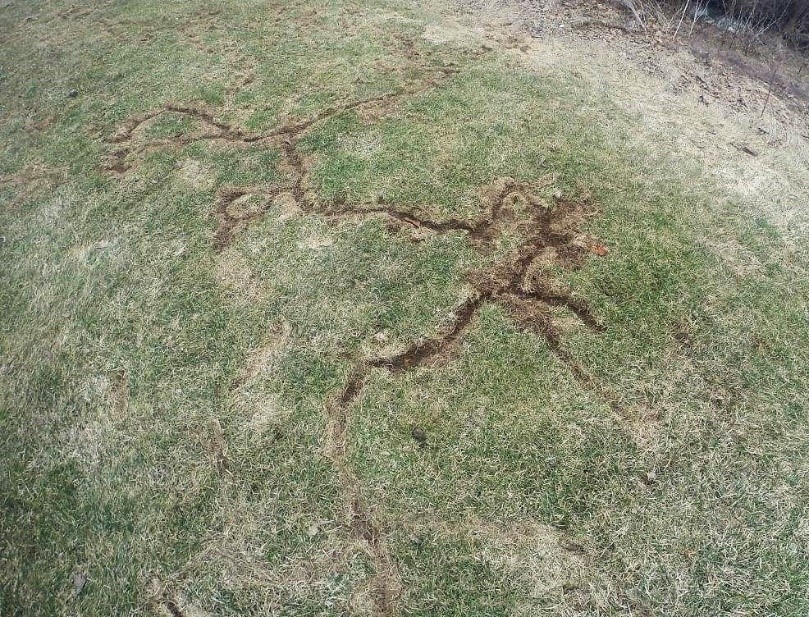
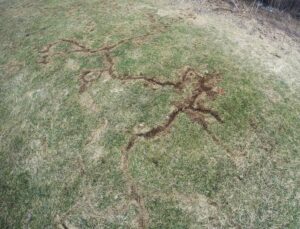
The picture above shows what runways from voles look like in a lawn. Learn more about getting rid of voles below.
What is a Vole?
Have you ever heard of a vole? Don’t worry, although this rodent is common, many people have never heard of them. Often referred to as meadow or field mice, these small rodents are generally dark brown or gray in color and only around five to eight inches in length, while their body is frequently more robust than a mouse.
Voles construct runways at the lawn surface with numerous burrow openings that typically stem from shrub beds or wood lines. In some cases, the network of runways can be extensive, covering a significant area of a property. While these trails can be found any time of the year, they are most often discovered as snow begins to melt in the early spring. Under snow cover and hidden from predators, voles will venture further into open areas foraging for food. Following a winter with persistent snow coverage for long periods, damage tends to be worse.
Distinguishing a Vole from a Mouse
Prior to protecting your property and getting rid of voles, it is important to be able to identify the mouse-like rodent as it differs from other rodents like moles, mice and rats. Voles are almost always mistaken for mice and one of the best ways to differentiate the rodents is by tail length. Mice have long tails that are equal to about half of their body length while voles’ tails are shorter. Their tail has thin hair and is darker on the upper side than the lower side. Another distinguishing characteristic includes their round head shape and blunt snout. The voles’ eyes are very small and black, and their ears are covered by fur.
There are several species of voles that are native to our area and eat a wide variety of plants, most frequently grasses and glasslike plants. In the late summer and fall they store seeds, tubers, bulbs, and rhizomes. They primarily eat bark in the fall and winter, and will also eat grain crops, especially when populations are high. Occasionally food items include snails, insects and animal remains. Voles are active day and night year-round, with peak activity being from dawn to dusk. Their home range is usually a quarter of an acre or less, but this range varies with season, population density, habitat and food supply.
Most importantly, voles need ground cover to survive and therefore avoid open ground areas. Cleared spaces as narrow as 10 inches inhibit their movements.
Although voles breed throughout the year, breeding is most common during spring and summer months. Generally, they have one to five litters per year and litter sizes range from one to 11 young and the gestation period is about 21 days. Further, the young are weaned by the time they are 21 days old, and females are sexually active in 35 to 40 days. Voles have short life spans that generally range from two to 16 months.
Getting Rid of Voles
Unfortunately, the eradication of voles is not easy for homeowners, nor is it completely necessary. However, if getting rid of voles is a priority, repellents or chemical lures can be effective in some cases but cannot provide one hundred percent control. Additionally, these chemical repellants should be used with caution due to subsequent effects on certain birds and other small mammals like chipmunks and squirrels.
Traditional mmousetraps(a ‘snap trap’) baited with food items and placed near the runways can also be effective in catching some voles. Nevertheless, this method does not reduce the vole population numbers significantly.
Protecting plants from voles in shrub beds can be done with a fence buried three to six inches below the soil surface and bent outward into an L shape. Above ground, the fence should be from four to 12 inches tall. Use non-rusting, one quarter inch mesh. Hardware cloth works well for this purpose.
Removing weeds, mulch and other crop litter around gardens will help protect plants. Create a bare border space around your garden or dig a trench twelve inches in depth and wide enough to step over easily to discourage voles. To learn more about weed control in mulch beds, check out helpful tips about applying pre-emergent weed control.
While getting rid of voles may be difficult, the damaged grass and plants can grow back! Once the grass begins actively growing, vole trails become less obvious. Spring fertilization helps speed the lawn’s recovery; however, minor touch up seeding may be necessary to further correct the issue.
Conclusion
One key takeaway about voles is that they prefer a location with cover. Expect to have less vole damage during mild winters with short periods of snow cover. If you are in our service area and have any questions about getting rid of voles, please feel free to call our office at 908-281-7888.
Turf Damaging Insects
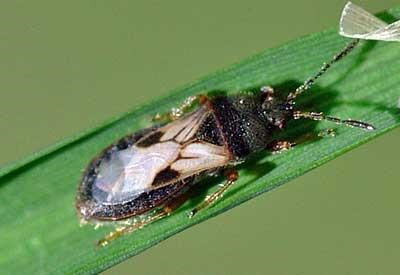
There are many types of insects that can damage a lawn, but we are going to focus on a few of the most common turf damaging insects in the New Jersey.
Grubs
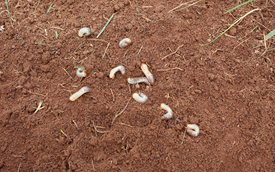
First of the lawn destroying insects are grubs, and they can cause substantial and costly damage in our area that requires seeding to repair.
Grubs are the sub-surface stage of beetles. There are many types of grubs found in the northeast, but as a group, the white grub is the most widespread and destructive turf insect in our area. Beetles lay their eggs in lawns. The eggs hatch and produce grubs that feed on the root system of the lawn. The most common species of beetles that people can commonly identify is the Japanese beetle. Beetles lay their eggs from June through the beginning of August.
The Identification of grubs is quite simple. They are a whitish cream color, accompanied by a brown head with chewing mandibles and three pairs of short jointed legs. They are usually found in a C-shaped posture.
The damaged caused by grubs can be quite extensive and is a result of the grubs chewing off roots close to the soil surface, severing the plant from the roots. A grass plant cannot survive without its roots. Signs of grub damage include thinning, yellowing, wilting and the appearance of scattered, irregular dead patches. The patches can increase in size and may join together to form larger areas of dead grass.
To find these turf damaging insects, go to the brown (dead areas) and pull at the grass, it comes up like a carpet. Beneath the layer of dead grass, you will be able to see grubs feeding. Secondary damage can also occur with the help of small animals, such as skunks, birds, raccoons and moles. They dig up the turf to feed on the grubs below. Below is a video that shows grubs in the lawn and how the turf pulls up like a carpet.
To avoid grubs and the damage associated with them, apply a preventative grub control in June or July. The process is quite simple; apply a grub control that waits in the soil for the grubs. This can be applied while the beetles are laying their eggs or a little bit before they start. The grub control product lasts in your lawn all summer long. For more information on grubs and grub control, here is a link to our grub control.
It is also recommend that you DO NOT put out Japanese beetle traps because this attracts more beetles that could potentially lay eggs in your lawn. If you have already purchased one or multiple of these bags, we recommend to get rid of them now. They do more harm than good because they attract more beetles than would naturally be in your yard.
Chinch Bugs
The next turf damaging insect popular to the area are chinch bugs. They can cause widespread and costly damage in home lawns. Chinch bugs reside in the thatch layer of the lawn during the winter months, this is also referred to as overwintering. Similar to grubs and other turf insects, their damage can be permanent and require seeding to repair.
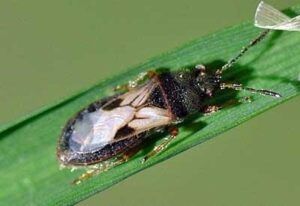 Chinch bugs typically have two generations per year and while looking you normally can spot the different stages of their life cycle. Chinch bugs start off in the egg stage, then they hatch into the nymph stage. The first nymphs are about 1mm and are bright red with a white band across their middle. The red changes to orange, then to an orange brown and finally black as the nymph’s progress. The last stage is the adult stage and adults are black with shiny white wings. There is a distinctive black spot near the margin of each forewing, and a black line extending diagonally toward the head. It looks as though there is a white X on their back.
Chinch bugs typically have two generations per year and while looking you normally can spot the different stages of their life cycle. Chinch bugs start off in the egg stage, then they hatch into the nymph stage. The first nymphs are about 1mm and are bright red with a white band across their middle. The red changes to orange, then to an orange brown and finally black as the nymph’s progress. The last stage is the adult stage and adults are black with shiny white wings. There is a distinctive black spot near the margin of each forewing, and a black line extending diagonally toward the head. It looks as though there is a white X on their back.
Chinch bugs feed by inserting their needle-like mouthparts into the crowns and stems of grasses and suck out the plant’s juices. At the same time, chinch bugs inject a toxic saliva into the plants which disrupts the flow of moisture, causing the plant to wilt and die.
Chinch bug damage can be quite extensive and costly to fix. Signs of chinch bug damage include gradual thinning, yellowing, wilting and the appearance of scattered, irregular dead patches. A chinch bug starts in one area and gradually grows outward, these patches can increase in size and may join together to form larger areas of dead grass. The dead grass does not pull up easily and the damage often times is confused with drought stress, disease or any number of other problems.
A surface insect control should be applied to stop further damage of the insect. Come the end of August, you can repair the damaged areas with seeding. Core aeration or dethatching should also be done annually to the lawn to reduce the thatch layer where the chinch bugs harbor over the winter.
Sod Webworm
The next turf damaging insect is the sod webworm, which are the larva of a moth. They overwinters down in the soil inside their silken tunnels. In the early spring they start to feed again, then in late May to early June they pupate in a cocoon emerging into adulthood as a moth.
The adult moths color pattern varies with each species and their size ranges from 1/2- to 3/4-inch long while sometimes having a small, dark line on the top of each wing cover. Two small, fingerlike projections are visible at the front of the head and look like a snout. When the moth is at rest, the wings wrap around its body, giving it a tube like shape. On warm evenings you can see the moths flying low over the lawn in a zigzag pattern. Adult females drop their eggs on to the ground while flying. These eggs then take 7 – 10 days to hatch.
Like the adult moths, the color pattern for the larva sod webworm varies with each species as well. Most sod webworms are greenish, grayish, or brownish, and usually have dark spots scattered along their bodies. The head capsule of the larger stages of sod webworm are light brown with dark markings.

Sod webworm feeding occurs mostly at night, during this time the sod webworm emerges from its silken tunnel and chew off the leaves and stems just above the crown of the grass plant. The damage starts out looking like small yellow or brown patches gradually increasing in size. Since they are night feeders you do not see these turf insects during the day; however, upon inspection of the turf you normally are able to see their silken tunnels in the soil and a green pellet-like matter called “frass,” which is sod webworm excrement.
Control for sod webworm is easy. An insecticide should be applied and watered in to wash the insect control off of the grass blade and down into the soil where the sod webworms are located. Damage from sod webworms could be permanent and should be evaluated for seeding in late August or September.
Conclusion
If you have had an issue with insects in the past, or think you may have turf damaging insects now and are located within our service area, please feel free to contact Fairway Green Inc. with any questions or for a free evaluation and estimate for an insect control. You can call us at 908-281-7888 or request an estimate on our website.



